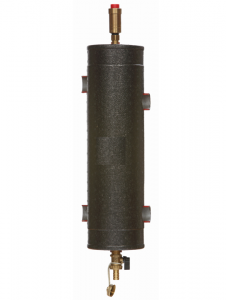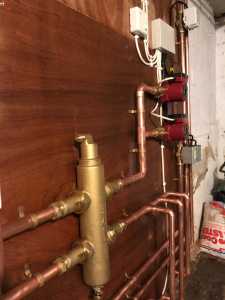Thank you for your reply- I have no idea if I have a low loss header, but I have had some success- I’ve tweaked the compensation curve- and that has had an effect on consumption. The house is still warm.
I think I’ve worked out why the stat appeared to be overriding the FTC- that’s because the hearing was ‘on’. Rather than on a timer.
I’ve now set the water to ‘Eco’ rather than normal to see how I get on.
Tweaking the curve made a bit difference to consumption yesterday so hopefully I’m on the right track.
I’ve asked the installers about pump speed v Delta T, as I don’t feel confident to adjust the pumps myself.
Overall I’m getting the hang of it- so when I hear back from the installers I’ll ask about the low loss header.
I think the installers want you to have a warm home and be happy. I think I need to understand how my system works so I feel confident it’s performing the best it can.
@cheshirecat you can look to see if you have one - it'll be near the inlet somewhere. They work by providing separation between your house and the heat pump.
The issue is they are basically a radiator and you can lose your nice hot water back to the cold return. So you'll see a close match between your flow out and return. You can see blow the examples. This strikes me as a prime suspect given what you said with temperatures.
Its very possible you don't need the LLH - I recently had mine removed and I have no issues. Its enabled me to lower my flow temps and vastly increase the heat into the house. Have a hunt and see if you can find it!!
Posted by: @derek-mThe auto adaptation system does not have any obvious method for the internal parameters of the controller to be adjusted by the operator, I must therefore assume that there is some form of self tuning algorithm built into the controller, which because of the relatively long response times within a home heating system, may take quite some time to adjust the controller parameters to match your system.
Initially you may find that it varies the LWT by larger than normal values, but these variations should reduce as the controller adjusts to your home.
I admire your faith in the Mitsubishi programmers but the "quite some time" in the current version of Ecodan auto adaptation (since last November's firmware update) may be long enough to bankrupt most people with this winter's electricity prices! There is no discernable reduction in the variations in the first few days of use. Auto-adapt mode always seems to thrash the heat pump to reach the desired internal temperature as soon as possible, even if it's simply switching from night-time set-back to daytime temperature.
It's a black box. There's no telling if it's the current version or the previous one that was working as intended, let alone whether its intentions are good.
Posted by: @cheshirecatI’ve asked the installers about pump speed v Delta T, as I don’t feel confident to adjust the pumps myself.
Does anyone know what mode a Grundfos pump in an Ecodan system should be set to anyway? The Ecodan has quite a wide range of acceptable flow rates (9-25 l/min for the 8.5kW I think) and the pump appears to offer a choice between Constant Pressure and Proportional Pressure modes, as well as 3 speeds of each.
So- weather compensation only then? I had thought I might do it.
The installers are coming out again this week to fiddle about with it, so we’ll see what happens then. Now I know that it uses at least 40kWh no matter what I tweak then I’ve a decent baseline to work from.
I turned off the overnight water heat to no effect - but the temps are down here overnight, so may just be reflecting that.
Posted by: @mjrPosted by: @derek-mThe auto adaptation system does not have any obvious method for the internal parameters of the controller to be adjusted by the operator, I must therefore assume that there is some form of self tuning algorithm built into the controller, which because of the relatively long response times within a home heating system, may take quite some time to adjust the controller parameters to match your system.
Initially you may find that it varies the LWT by larger than normal values, but these variations should reduce as the controller adjusts to your home.
I admire your faith in the Mitsubishi programmers but the "quite some time" in the current version of Ecodan auto adaptation (since last November's firmware update) may be long enough to bankrupt most people with this winter's electricity prices! There is no discernable reduction in the variations in the first few days of use. Auto-adapt mode always seems to thrash the heat pump to reach the desired internal temperature as soon as possible, even if it's simply switching from night-time set-back to daytime temperature.
It's a black box. There's no telling if it's the current version or the previous one that was working as intended, let alone whether its intentions are good.
As you state it is a black box, so we don't know what is happening internally within the controller. I am used to industrial control systems, where one can modify the internal parameters to achieve the correct control response.
I would have hoped that a company like Mitsubishi would have fully tested such a system before releasing it onto the market, but I don't know for certain.
Maybe it would be useful for one or two of you Ecodan owner's to e-mail Mitsubushi and ask for a detailed explanation of how Auto Adaptation is supposed to function.
Posted by: @mjrPosted by: @cheshirecatI’ve asked the installers about pump speed v Delta T, as I don’t feel confident to adjust the pumps myself.
Does anyone know what mode a Grundfos pump in an Ecodan system should be set to anyway? The Ecodan has quite a wide range of acceptable flow rates (9-25 l/min for the 8.5kW I think) and the pump appears to offer a choice between Constant Pressure and Proportional Pressure modes, as well as 3 speeds of each.
As far as I am aware, the Ecodan has an internal water pump, the speed of which the controller varies to maintain the Delta T at the heat pump.
If you have an external water pump within your system, I must assume that you also have some form of hydraulic separation between the heat pump circuit and the central heating circuit.
For something like a buffer tank to operate most efficiently, the flow rate going in should be equal to the flow rate coming out, but I am not certain how you could achieve this if the pump 'pushing' the water in is being controlled automatically, whilst the pump 'pulling' the water out is set manually. It is like a stopped clock, it may only be correct two times each day.
I would be interested to hear what any installers have to say on the subject.
One way around it is to use a PWM controlled pump on the secondary circuit too, piggybacked off the ASHP control boards PWM signal (provided it is available, mine is).... But if you're going to do that, you might as well ditch the buffer in the middle.
Off grid on the isle of purbeck
2.4kW solar, 15kWh Seplos Mason, Outback power systems 3kW inverter/charger, solid fuel heating with air/air for shoulder months, 10 acres of heathland/woods.
My wife’s house: 1946 3 bed end of terrace in Somerset, ASHP with rads + UFH, triple glazed, retrofit IWI in troublesome rooms, small rear extension.
Posted by: @derek-mIf you have an external water pump within your system, I must assume that you also have some form of hydraulic separation between the heat pump circuit and the central heating circuit.
Not according to the paper schematic I have, but the circulation pump is wired into the ecodan control unit. Actually, it's not clear to me whether the pump control panel is overridden by the control unit. If so, I'm wondering about something that I cannot change anyway!
Posted by: @cheshirecatSo- weather compensation only then? I had thought I might do it.
The installers are coming out again this week to fiddle about with it, so we’ll see what happens then. Now I know that it uses at least 40kWh no matter what I tweak then I’ve a decent baseline to work from.
I'm currently using weather compensation with a home automation system preventing overheating (acting as a smart thermostat) and making slight adjustments to reflect weather and activity in the house. In theory, it's an awful thing to do. In practice, it keeps us warm and not bankrupted. I make no claims that it's the right thing for anyone else to do, but you might like to test it.
Take pictures or notes of the settings screens after they've adjusted it and between each thing you try, so you can step back if needed. But you probably already knew that.
Posted by: @hughfOne way around it is to use a PWM controlled pump on the secondary circuit too, piggybacked off the ASHP control boards PWM signal (provided it is available, mine is).... But if you're going to do that, you might as well ditch the buffer in the middle.
You have a Samsung ASHP, which does not have an internal water pump, hence the need for the PWM control signal, whether it is used or not, to control an external water pump. I'm not certain if other manufacturer's provide a speed control signal for external water pumps.
Posted by: @mjrPosted by: @derek-mIf you have an external water pump within your system, I must assume that you also have some form of hydraulic separation between the heat pump circuit and the central heating circuit.
Not according to the paper schematic I have, but the circulation pump is wired into the ecodan control unit. Actually, it's not clear to me whether the pump control panel is overridden by the control unit. If so, I'm wondering about something that I cannot change anyway!
Would you care to post a photo of your schematic and details of your circulation pump?
- 26 Forums
- 2,364 Topics
- 53.6 K Posts
- 255 Online
- 6,027 Members
Join Us!
Worth Watching
Latest Posts
-
RE: Octopus Cosy Heat Pump Owners & Discussion Thread
@andrewj they will release smarter controls, its been m...
By swwils , 2 minutes ago
-
People apparently, at least according to the polls, say...
By JamesPa , 15 minutes ago
-
RE: Speedcomfort radiator fans
Thats true, but having tried (and succeeded) in constru...
By JamesPa , 22 minutes ago
-
RE: Solis S6-EH1P8K-L-PLUS – Why I Chose It and What I’ve Learned So Far
@bash brilliant, thanks for the feedback
By energy9165 , 2 hours ago
-

RE: Setback savings - fact or fiction?
The OpenWeatherMap API provides plenty of historical da...
By Majordennisbloodnok , 2 hours ago
-

RE: Heat Pump Heats the House… But It’s Not Cosy. Emitter Changes or System Tweak?
@alastair There I was, feeling grumpy, he said “Cheer u...
By Toodles , 4 hours ago
-
RE: Grant Aerona: Is there a setting to keep the 2-port valve open during pump blockade
Depends on OAT. Mine cycles at OAT>10 and of course...
By JamesPa , 6 hours ago
-
RE: New Fogstar 15.5kWh upright solution
@transparent My conclusion is as you have noted, tha...
By Bash , 6 hours ago
-

That makes sense to me,although we don't know what the ...
By Transparent , 8 hours ago
-
RE: Mitsubishi Ecodan R290 10kW performance
And to you too. Wishing you a very enjoyable festive s...
By Sheriff Fatman , 9 hours ago
-

RE: External pipework insulation
They do? But that isn't apparent from the photos we'r...
By Transparent , 11 hours ago
-
RE: My Powerwall 3 Consumes 3-4 kWh/Day in Self-Consumption: Is This Normal?
@editor Thank you so much for looking into this for me ...
By Caron , 11 hours ago
-

RE: Say hello and introduce yourself
@velcro welcome to the forums. Please feel free start a...
By Mars , 1 day ago
-
Daikin EDLA11D3V3 DHW Settings
I have a newly installed EDLA11D3V3 which I'm still get...
By Velcro , 1 day ago
-

RE: Need Help Optimising My Rushed ECO4 Install: 12kW Bosch Heat Pump
Hi @mickamills . Welcome to the forum. It sounds like...
By bontwoody , 1 day ago
-
RE: Midea ASHP – how to set weather compensation
@curlykatie did you get sorted with this?
By MickaMills , 1 day ago
-
RE: MyVaillant Connect Regular Disconnect
Thanks. Yes, if the time is consistently 11pm every nig...
By buckwem , 2 days ago
-
RE: Who's your electricity provider and what's your tariff?
@transparent Thanks, this helps. Could it be that St...
By Batpred , 2 days ago









